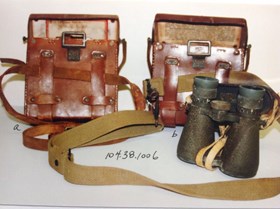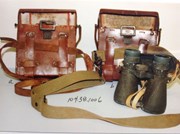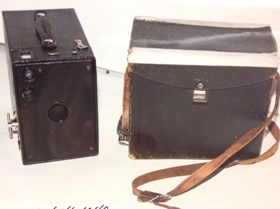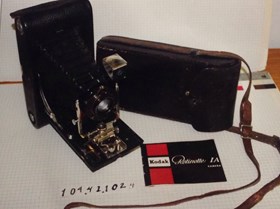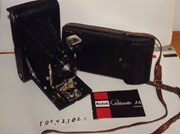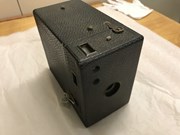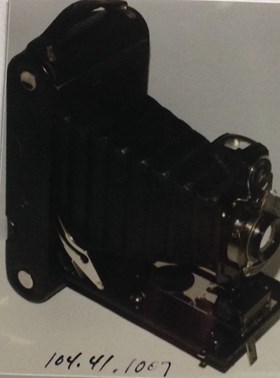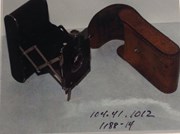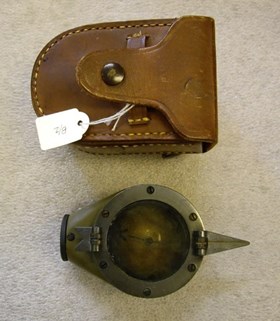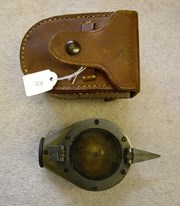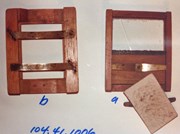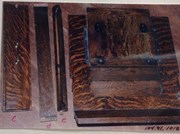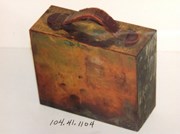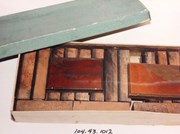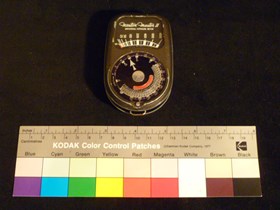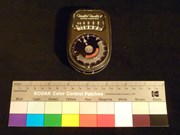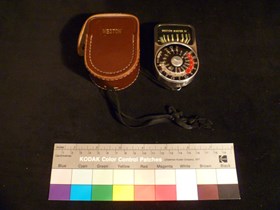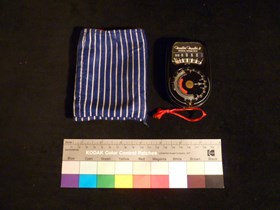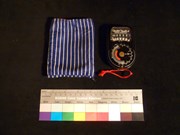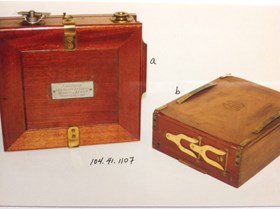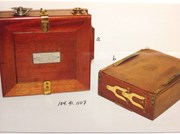Narrow Results By
- Date
- 1918 – 1921
- Material
- skin; metal; plastic; rubber
- Catalogue Number
- 103.08.1016
- Description
- Black rubber coated cylindrical duffle bag, leather handles at each end, opening 36.0 has leather flap which closes over a leather strip rivetted onto bag, 4 buckles on strip slides through slits on flap through which another leather strap slides through to lock opening, a small lock is locked onto…
1 image
- Title
- Bag
- Date
- 1918 – 1921
- Material
- skin; metal; plastic; rubber
- Dimensions
- 29.0 x 32.0 x 78.0 cm
- Description
- Black rubber coated cylindrical duffle bag, leather handles at each end, opening 36.0 has leather flap which closes over a leather strip rivetted onto bag, 4 buckles on strip slides through slits on flap through which another leather strap slides through to lock opening, a small lock is locked onto metal loop, another flap covers this opening, it has three straps which correspond to 3 buckles attached to main body.
- Subject
- Edward Oliver Wheeler
- photography
- Credit
- Gift of Helen Shandruk, Banff, 1984
- Catalogue Number
- 103.08.1016
Images
This material is presented as originally created; it may contain outdated cultural descriptions and
potentially offensive content.
Read more.
- Date
- 1917
- Material
- skin; fibre; metal; glass; paper
- Catalogue Number
- 104.38.1006 a,b
- Description
- Two pair binoculars in leather cases. Binoculars of dark green metal marked: “CARL ZEISS. JENA. Fernglas 08” Pair (a) has “Nr. 26615” & “IV 1917” and pair (b) marked “Nr. 31134” & “V 1917”. Both cases have label of German text inside lid. Case (a) has a label on top of original label which reads: “…
1 image
- Title
- Binoculars
- Date
- 1917
- Material
- skin; fibre; metal; glass; paper
- Dimensions
- 14.5 x 8.0 x 17.5 cm
- Description
- Two pair binoculars in leather cases. Binoculars of dark green metal marked: “CARL ZEISS. JENA. Fernglas 08” Pair (a) has “Nr. 26615” & “IV 1917” and pair (b) marked “Nr. 31134” & “V 1917”. Both cases have label of German text inside lid. Case (a) has a label on top of original label which reads: “Please return to: George Vaux Jr. Gulph Rd. Bryn Mawr. Penna. U.S.A.” Case (a) has leather strap and case (b) has a canvas strap.
- Subject
- photography
- Vaux family
- sports
- hiking
- tourism
- military
- Credit
- Gift of Molly Vaux, New York, USA, 1999
- Catalogue Number
- 104.38.1006 a,b
Images
This material is presented as originally created; it may contain outdated cultural descriptions and
potentially offensive content.
Read more.
- Date
- 1914 – 1930
- Material
- cardboard, metal, glass
- Catalogue Number
- 104.41.1054
- Description
- Six-16 Brownie Junior box camera; metal face plate with make and model written; depression in centre for internal lens; 2 viewfinder lenses above lens; viewfinder window beside carrying strap on top; pull out aperture selector; viewfinder window; shutter release; film advance, right side; red film …
1 image
- Title
- Box Camera
- Date
- 1914 – 1930
- Material
- cardboard, metal, glass
- Dimensions
- 14.2 x 13.9 x 9.1 cm
- Description
- Six-16 Brownie Junior box camera; metal face plate with make and model written; depression in centre for internal lens; 2 viewfinder lenses above lens; viewfinder window beside carrying strap on top; pull out aperture selector; viewfinder window; shutter release; film advance, right side; red film frame window at back; textured black leatherette covers body.
- Subject
- photography
- Credit
- Gift of Robert N. Smith, Canmore, 1985
- Catalogue Number
- 104.41.1054
Images
This material is presented as originally created; it may contain outdated cultural descriptions and
potentially offensive content.
Read more.
- Date
- 1914
- Material
- wood, paperboard, glass, metal
- Catalogue Number
- 104.41.1040
- Description
- Kodak box camera with case; regular box camera; body made of cardboard with wood back and front; holein front is lens and shutter, 2 windows top corner for viewfinders top andside; 2 pull posts, one for aperture, other to keep shutter open; shutterrelease on right hand side, along with film advance…
1 image
- Title
- Box Camera
- Date
- 1914
- Material
- wood, paperboard, glass, metal
- Dimensions
- 17.1 x 14.3 x 11.0 cm
- Description
- Kodak box camera with case; regular box camera; body made of cardboard with wood back and front; holein front is lens and shutter, 2 windows top corner for viewfinders top andside; 2 pull posts, one for aperture, other to keep shutter open; shutterrelease on right hand side, along with film advance knob; round amber window in back; back detached; cardboard box covered with cloth; flap comes over toplatches at clip which has "Brownie" in fancy letters, also has a leather strapon the case.
- Subject
- photography
- Hubert Green
- Credit
- Gift of Hubert E. Green Jr., Banff, 1986
- Catalogue Number
- 104.41.1040
Images
This material is presented as originally created; it may contain outdated cultural descriptions and
potentially offensive content.
Read more.
- Date
- 1915 – 1922
- Material
- wood; leatherette; glass; metal
- Catalogue Number
- 104.41.1202
- Description
- Black wood box covered in leatherette and metal hardware. Missing handle at the top, two view finders (standard on box cameras) one landscape and one portrait. Four visible aperture settings on the shutter. Two other holes in the top left of the front of the camera.
1 image
- Title
- Box Camera
- Date
- 1915 – 1922
- Material
- wood; leatherette; glass; metal
- Dimensions
- 16.5 x 12.5 x 17 cm
- Description
- Black wood box covered in leatherette and metal hardware. Missing handle at the top, two view finders (standard on box cameras) one landscape and one portrait. Four visible aperture settings on the shutter. Two other holes in the top left of the front of the camera.
- Credit
- Gift of Harold C. Whyte, Penticton, 2017
- Catalogue Number
- 104.41.1202
Images
This material is presented as originally created; it may contain outdated cultural descriptions and
potentially offensive content.
Read more.
- Date
- 1915 – 1930
- Material
- paper; glass; skin; metal
- Catalogue Number
- 104.41.1024 a-c
- Description
- Large Kodak Autographic camera (a) with a leather carrying case (b) and operation manual (c).
1 image
- Title
- Camera
- Date
- 1915 – 1930
- Material
- paper; glass; skin; metal
- Description
- Large Kodak Autographic camera (a) with a leather carrying case (b) and operation manual (c).
- Subject
- households
- photography
- hobbies
- Credit
- Gift of J. H. Doughty-Davies, Victoria, 1991
- Catalogue Number
- 104.41.1024 a-c
Images
This material is presented as originally created; it may contain outdated cultural descriptions and
potentially offensive content.
Read more.
- Date
- 1910 – 1940
- Material
- metal; skin
- Catalogue Number
- 104.41.1074
- Description
- One Kodak, model 116, box camera.
1 image
- Title
- Camera
- Date
- 1910 – 1940
- Material
- metal; skin
- Description
- One Kodak, model 116, box camera.
- Subject
- households
- photography
- Credit
- Gift of Hilda Stuckert, Banff, 1985
- Catalogue Number
- 104.41.1074
Images
This material is presented as originally created; it may contain outdated cultural descriptions and
potentially offensive content.
Read more.
- Date
- 1918 – 1930
- Material
- skin; metal; glass
- Catalogue Number
- 104.41.1007
- Description
- Black folding camera with textured leather on the casing and a carrying handle. A metal tab with “Kodak” in an Old English font pulls open the case. The camera has accordian pleated bellows that move along a metal frame. A reflective viewfinder is fastened above the Bausch & Lomb lens. There is…
1 image
- Title
- Camera
- Date
- 1918 – 1930
- Material
- skin; metal; glass
- Dimensions
- 23.3 x 11.0 x 19.3 cm
- Description
- Black folding camera with textured leather on the casing and a carrying handle. A metal tab with “Kodak” in an Old English font pulls open the case. The camera has accordian pleated bellows that move along a metal frame. A reflective viewfinder is fastened above the Bausch & Lomb lens. There is a manufacturer’s plate on the front of the bellows framework “No 2C Autographic Kodak Jr. Use film No. A 130.” The back of the camera has a hinged opening with a metal scribner for writing on negative.
- Subject
- photography
- Credit
- Gift of Unknown, 1968
- Catalogue Number
- 104.41.1007
Images
This material is presented as originally created; it may contain outdated cultural descriptions and
potentially offensive content.
Read more.
- Date
- 1885 – 1890
- Material
- wood; metal; skin
- Catalogue Number
- 104.41.1010 a,b
- Description
- “Premo D” folding camera (4”x5” format) with a leather covered wooden frame. The camera has a leather handle centred on the top and held in place with brass keepers. The hinged front of the camera opens to lie flat and has a brass track (3.2 cm wide) running down the centre. The red leather bell…
1 image
- Title
- Camera
- Date
- 1885 – 1890
- Material
- wood; metal; skin
- Dimensions
- 12.0 x 14.5 x 17.5 cm
- Description
- “Premo D” folding camera (4”x5” format) with a leather covered wooden frame. The camera has a leather handle centred on the top and held in place with brass keepers. The hinged front of the camera opens to lie flat and has a brass track (3.2 cm wide) running down the centre. The red leather bellows extend along the track and end with a wooden frame that holds a lens (missing) and a viewfinder. The camera also has hinged doors on the right side and on the back.b) Film plate holder loaded in the camera’s side chamber.
- Subject
- households
- photography
- hobbies
- Credit
- Gift of Unknown, 1968
- Catalogue Number
- 104.41.1010 a,b
Images
This material is presented as originally created; it may contain outdated cultural descriptions and
potentially offensive content.
Read more.
- Date
- 1917 – 1935
- Material
- metal; skin
- Catalogue Number
- 104.41.1012 a,b
- Description
- A camera and case.a) Oblong camera, “Kodak Anastigmatic” folding autographic, with leather covering the front and back. The sides of the camera are texured metal. The front pulls out 7.0 cm and jointed supports hold the black bellows. The camera has an adjustable viewfinder. The back of the came…
1 image
- Title
- Camera
- Date
- 1917 – 1935
- Material
- metal; skin
- Dimensions
- 12.0 x 2.6 x 6.2 cm
- Description
- A camera and case.a) Oblong camera, “Kodak Anastigmatic” folding autographic, with leather covering the front and back. The sides of the camera are texured metal. The front pulls out 7.0 cm and jointed supports hold the black bellows. The camera has an adjustable viewfinder. The back of the camera has a hinged plated with a stylus, a removable 4.6 diameter metal plate at the centre, and a small oblong metal plate that has the manufaturer’s name.b) Leather case with doubouble thickness sides and snap closures. The name “James A. Pogue” and his address is written inside the flap of the case.
- Subject
- households
- photography
- Jim Pogue
- Credit
- Gift of Sally Pogue, 1970
- Catalogue Number
- 104.41.1012 a,b
Images
This material is presented as originally created; it may contain outdated cultural descriptions and
potentially offensive content.
Read more.
- Date
- 1883 – 1926
- Material
- cardboard; metal; glass;
- Catalogue Number
- 104.41.0129 a,b
- Description
- Two camera lenses housed in a repurposed Hammond box with “OLD ‘ADON’ Telephoto in shutter circa 1990’s” written in black ink on the front.The larger lens with shutter was manufactured by Bausch & Lomb Optical Co., originally a company that produced prescription eye-wear in the mid to late-1800s be…
1 image
- Title
- Camera Lenses
- Date
- 1883 – 1926
- Material
- cardboard; metal; glass;
- Dimensions
- 5.7 x 7.8 x 14.5 cm
- Description
- Two camera lenses housed in a repurposed Hammond box with “OLD ‘ADON’ Telephoto in shutter circa 1990’s” written in black ink on the front.The larger lens with shutter was manufactured by Bausch & Lomb Optical Co., originally a company that produced prescription eye-wear in the mid to late-1800s before expanding into camera lenses and microscopes/telescopes towards the turn of the century. The company was founded in Rochester NY.The smaller lens was manufactured by Gundlach-Manhattan Optical Co., a merged company between Gundlach Optical Co. and Manhattan Optical Co. that took place in 1902, which produced various kinds of bellows cameras. Both companies were based in Rochester NY prior to merging.
- Credit
- Gift of Nicholas Morant, Banff, 2006
- Catalogue Number
- 104.41.0129 a,b
Images
This material is presented as originally created; it may contain outdated cultural descriptions and
potentially offensive content.
Read more.
- Date
- c. 1915
- Material
- metal; glass; skin
- Catalogue Number
- 104.44.1013 a-c
- Description
- 3 prismatic compasses, olive-drab painting on the body, military issue, marked: “U.S.E.D. CREAGH-OSBORNE MARCHING COMPASS. MARK VII. MOD.E. SPERRY GYROSCOPE CO. BROOKLYN, N.Y. In leather carrying cases. “Captain Frank Osborne Creagh-Osborne, Royal Navy, (1867/1943) was Superintendent of Compasses …
1 image
- Title
- Compass
- Date
- c. 1915
- Material
- metal; glass; skin
- Dimensions
- 9.0 x 7.0 cm
- Description
- 3 prismatic compasses, olive-drab painting on the body, military issue, marked: “U.S.E.D. CREAGH-OSBORNE MARCHING COMPASS. MARK VII. MOD.E. SPERRY GYROSCOPE CO. BROOKLYN, N.Y. In leather carrying cases. “Captain Frank Osborne Creagh-Osborne, Royal Navy, (1867/1943) was Superintendent of Compasses with the British Admiralty and inventor. His various inventions were built by H. Hughes & Son Ltd, Dent & Co & Johnson Ltd, Sperry Gyroscopes Co., etc. There exist two versions of a sturdy and heavy LENSATIC marching compass made by SPERRY GYROSCOPE Co. BROOKLYN N.Y.” “MARK VII MOD.E. Technical Data: - Foldable rifle-type sighting system- Adjustable lense- Case: brass- Dimensions: 85 x 60 x 32 mm- Weight: 230 gr- Fluid damped compass card”Quoted material from: http://www.compassmuseum.com/hand/hand_2.htm
- Credit
- Gift of Molly Vaux, New York, USA, 1999
- Catalogue Number
- 104.44.1013 a-c
Images
This material is presented as originally created; it may contain outdated cultural descriptions and
potentially offensive content.
Read more.
Contact-Printing Frame
https://archives.whyte.org/en/permalink/artifact104.41.1006%20a%2cb
- Date
- 1915 – 1930
- Material
- glass; metal; wood
- Catalogue Number
- 104.41.1006 a,b
- Description
- Two small wood frames with glass and metal pressure holders at the back.
1 image
- Title
- Contact-Printing Frame
- Date
- 1915 – 1930
- Material
- glass; metal; wood
- Description
- Two small wood frames with glass and metal pressure holders at the back.
- Subject
- households
- hobbies
- photography
- Credit
- Gift of L. A. E Duncan, Calgary, 1984
- Catalogue Number
- 104.41.1006 a,b
Images
This material is presented as originally created; it may contain outdated cultural descriptions and
potentially offensive content.
Read more.
Copy Stand Parts
https://archives.whyte.org/en/permalink/artifact104.41.1018%20a-e
- Date
- 1910 – 1930
- Material
- wood, metal
- Catalogue Number
- 104.41.1018 a-e
- Description
- 5 pieces dark oak; photographic stand parts; solid wood 2.0 cm thick; (a) 56.0x56.0 with a 53.5x13.0 ledge at an angle; a 5.0 bar across back; inset into front is (b) 35.5x35.5, has 4 metal'shoes' 2 round 4.5 diameter and 2 square, open one side; slides under 2metal bars on (a); (c) 13.0x56…
1 image
- Title
- Copy Stand Parts
- Date
- 1910 – 1930
- Material
- wood, metal
- Description
- 5 pieces dark oak; photographic stand parts; solid wood 2.0 cm thick; (a) 56.0x56.0 with a 53.5x13.0 ledge at an angle; a 5.0 bar across back; inset into front is (b) 35.5x35.5, has 4 metal'shoes' 2 round 4.5 diameter and 2 square, open one side; slides under 2metal bars on (a); (c) 13.0x56.0 part of drawer, with lock one end and brasshandle centered;(d) 7.6x63.0, 2 holes each end; (e) 58.0x5.0; wedge shaped with nipple one end.
- Subject
- photography
- Credit
- Gift of Unknown, 1968
- Catalogue Number
- 104.41.1018 a-e
Images
This material is presented as originally created; it may contain outdated cultural descriptions and
potentially offensive content.
Read more.
Cut-Film Holder
https://archives.whyte.org/en/permalink/artifact104.41.1104
- Date
- 1885 – 1900
- Material
- metal; skin
- Catalogue Number
- 104.41.1104
- Description
- Metal box with opening compartments and leather carrying handle marked “45”. “Pat. May 31. 87. Aug. 3. 90” stamped on top. Spring loaded film changing apparatus inside.
1 image
- Title
- Cut-Film Holder
- Date
- 1885 – 1900
- Material
- metal; skin
- Dimensions
- 4.5 x 11.5 cm
- Description
- Metal box with opening compartments and leather carrying handle marked “45”. “Pat. May 31. 87. Aug. 3. 90” stamped on top. Spring loaded film changing apparatus inside.
- Subject
- photography
- Vaux family
- Credit
- Gift of Molly Vaux, New York, USA, 1999
- Catalogue Number
- 104.41.1104
Images
This material is presented as originally created; it may contain outdated cultural descriptions and
potentially offensive content.
Read more.
Engraving Plate
https://archives.whyte.org/en/permalink/artifact104.43.1012
- Date
- 1915 – 1930
- Material
- metal; wood
- Catalogue Number
- 104.43.1012
- Description
- 16 copper engraving plates mounted on wooden blocks in cardboard box marked in pencil: “Copper negatives of Camping trips CBH.” 10 of the plates have images of camping, mountain scenes, trail riding, etc. 6 of the plates have images which appear to be from the Middle East - desert scenes, camels, e…
1 image
- Title
- Engraving Plate
- Date
- 1915 – 1930
- Material
- metal; wood
- Dimensions
- 2.5 x 6.0 x 10.0 cm
- Description
- 16 copper engraving plates mounted on wooden blocks in cardboard box marked in pencil: “Copper negatives of Camping trips CBH.” 10 of the plates have images of camping, mountain scenes, trail riding, etc. 6 of the plates have images which appear to be from the Middle East - desert scenes, camels, etc. Some blocks are labeled “Hinman” or “Mrs. Hinman” and two are labeled “Smith.”These items were transferred to the Archives by SS in May/June 2014.
- Credit
- Gift of Molly Vaux, New York, USA, 1999
- Catalogue Number
- 104.43.1012
Images
This material is presented as originally created; it may contain outdated cultural descriptions and
potentially offensive content.
Read more.
Exposure Meter
https://archives.whyte.org/en/permalink/artifact104.41.1118
- Date
- 1888
- Material
- metal; paint; plastic
- Catalogue Number
- 104.41.1118
- Description
- Hand held exposure/light meter made by Weston Electrical Instrument Company in a grey metal finish. Along both sides of the meter are a series of protruding lines that allow one to safely grip the object. At the bottom of the artifact there is a metal hook, which would have allowed a string to be a…
1 image
- Title
- Exposure Meter
- Date
- 1888
- Material
- metal; paint; plastic
- Dimensions
- 2.0 x 6.0 x 9.5 cm
- Description
- Hand held exposure/light meter made by Weston Electrical Instrument Company in a grey metal finish. Along both sides of the meter are a series of protruding lines that allow one to safely grip the object. At the bottom of the artifact there is a metal hook, which would have allowed a string to be attached like on the other Weston meter’s owned by Nicholas. There is also no longer a case to protect this particular object. In the top of the exposure meter there is a clear plastic covering. Along the very top there us the name of the manufacturer in white cursive lettering that reads “Weston Master II” and written underneath in capital letters “UNIVERSAL EXPOSURE METER.” Below this is the light scale where the value of the scene would be indicated. The scale contains the values “0” “25” “50” “100” “200” “400” “800” “1600,” which means that the two values on this instrument are calibrated 0-50 and 0-1600. (candles per square foot.)Below there is a circular face with several figures and a dial that turns/rotates. The outside row of figures on the exposure control dial represents the light value settings and corresponds to the light values on the light scale. Below the round dial there is a tiny circular button that is used to set the exposure control dial for film speed. As the dial turns it reveals the “EMULSION SPEED” with a red baize finish that has become worn throughout its life. The row of figures at the bottom of the top dial is the f/stop values and has an “f” to make this more apparent for the user. The row of figures directly below the f/stop settings are the shutter speeds. After setting the exposure control dial to the light value obtained on the light scale, any of the combinations of f/stop and shutter speed directly opposite each other are correct. On the rear of the meter there is a black plastic covering that contains several circular cut outs that are called a hir.ged baffle. This can be swung open (against the case) using the gold latch, which clips into a tiny hole or socket when the user wishes it to be closed. When opened the light sensitive photo cell is directly beneath this baffle and contains several protruding circles. When the baffle is open, the scale range is 0-50; when the baffle is closed, the scale range is 0-1600. Below there is an oval shaped face with extensive information that is held in place with two small screws on both the viewer left and right side. There is silver lettering on a black background that reads “WESTON ELEC. INST. CORP.” “NEWARK, N.J., U.S.A.” A silver backing separates the patent information and has black writing that reads “MODEL 735” on the viewer left side. On the viewer right side the number “7454510” is engraved. In the middle there is a gold-coloured screw with the words “ZERO CORRECTOR” written in black. Below this there is the patent information; “U.S. PATENTS” “2,274,441” “2,073,790” “2,346,555” “2,137,466” “2,463,770.” Below these numbers are the “FOREIGN PATENTS” “FRENCH 862,770” “BRITISH 531,996” “CAN. 347,085” “CAN. 411,975” At the very bottom underneath there is the manufacturer’s location; “MADE IN U.S.A.”
- Subject
- photography
- Nick Morant
- Credit
- Gift of Nicholas Morant, Banff, 2006
- Catalogue Number
- 104.41.1118
Images
This material is presented as originally created; it may contain outdated cultural descriptions and
potentially offensive content.
Read more.
- Date
- 1888
- Material
- leather; metal; nylon; plastic; thread; paint
- Catalogue Number
- 104.41.1119 a-b
- Description
- Hand held light meter in a pear shape with a stainless steel body and leather case. Along both sides of the meter are a series of protruding lines that allow one to safely grip the object. On the viewer right there is a pointer lock, which is locked when positioned upwards and released when positio…
1 image
- Title
- Exposure Meter
- Date
- 1888
- Material
- leather; metal; nylon; plastic; thread; paint
- Dimensions
- 2.0 x 5.0 x 9.0 cm
- Description
- Hand held light meter in a pear shape with a stainless steel body and leather case. Along both sides of the meter are a series of protruding lines that allow one to safely grip the object. On the viewer right there is a pointer lock, which is locked when positioned upwards and released when positioned downward. At the bottom of the artifact there is a metal hook, which has a black string running through. In the top of the light meter there is clear plastic covering. Written in capital letters is “WESTON MATER IV” above the light scale. The lights scale contains the numbers “0” “25” “50” “100” “200” “400” “800” “1600,” which means that the 2 values calibrated on this instrument are 0-50 and 0-1600.Below there is another light scale in the form of a circular face with several figures and a dial that turns/rotates. The dial on the outside has a series of protruding lines to make movement easier and contains a row of figures. This dial controls the lens aperture (f/stop) scale and has a series of values representing the focal length of the lens; “1” “1.4” “2” “2.8” “4” “5.6”. On the same dial there is also the letters “EVS,” which stands for the exposure value setting with a cut out window that reveals the EVS values. Working in a clockwise direction (on the same dial) there is also the letters “U,” “A with “1/2” over top,” an enclosed arrow that is known as the normal arrow, a “C” with “2x” on top of it, and a “0”. As this dial is turned it reveals a partly red baize and black numbers on a silver background that represents the shutter speeds in fractions of seconds. The inside dial has a series of light scale values and an exposure index window that line up with the “U,” “A,” normal arrow, “C,” and “0.” On the opposite side of the exposure index window is the exposure index knob. On the rear of the meter there is a black plastic covering that contains several circular cut outs that are called a hir.ged baffle. This can be swung open (against the case) using the gold latch, which clips into a tiny hole or socket when the user wishes it to be closed. When opened the light sensitive photo cell is directly beneath this baffle and contains several protruding circles. When the baffle is open, the scale range is 0-50; when the baffle is closed, the scale range is 0-1600. Below there is an oval shaped face with extensive information that is held in place with two small screws on both the viewer left and right side. There is black lettering on a silver background that reads “UNIVERSAL EXPOSURE METER” “MODEL 745” SER.W” and “107522” engraved. Below the manufacturer information is listed; “DAYSTROM. INCORPORATED” “WESTON INSTRUMENTS DIVISION”. “NEWARK. N.J.. U.S.A.” In the middle there is a gold-coloured screw with the words “ZERO CORRECTOR” written in black. On the viewer left side of the zero corrector there is patent information; “U.S. PATENTS” “2463770” and on the viewer right side “FOREIGN PATS” “CAN. 411975”. At the very bottom on either side of a circular cut out are “ASA” and “K=1.0” written. Underneath “MADE IN JAPAN” has also been written.There is also a brown leather case with this object. The front has “WESTON” written in gold letters. On the viewer left there is a brown button that allows the case to be opened or fastened shut. The leather has been stitched together with light brown thread that is visible. The bottom of the case has an opening for the black string to be strung through so that the light meter and case are attached. On the rear there is a brown leather strap stitched.
- Subject
- photography
- Nick Morant
- Credit
- Gift of Nicholas Morant, Banff, 2006
- Catalogue Number
- 104.41.1119 a-b
Images
This material is presented as originally created; it may contain outdated cultural descriptions and
potentially offensive content.
Read more.
- Date
- 1888
- Catalogue Number
- 104.41.1120 a-b
- Description
- Hand held light meter in a pear shape with a stainless steel body and leather case. Along both sides of the meter are a series of protruding lines that allow one to safely grip the object. At the bottom of the artifact there is a metal hook, which has a red string running through.There is a clear p…
1 image
- Title
- Exposure Meter
- Date
- 1888
- Description
- Hand held light meter in a pear shape with a stainless steel body and leather case. Along both sides of the meter are a series of protruding lines that allow one to safely grip the object. At the bottom of the artifact there is a metal hook, which has a red string running through.There is a clear plastic covering located at the top of the meter. Written in cursive letters is the company name “WESTON MATER II”. Underneath this written in capital letters is “UNIVERSAL EXPSOURE METER”. The light scale underneath contains the numbers “0” “25” “50” “100” “200” “400” “800” “1600,” which means that the 2 values calibrated on this instrument are 0-50 and 0-1600. Underneath the scale the word “Light” is present. Below there is another light scale in the form of a circular face with several figures and a dial that turns/rotates. The outside row of figures on the exposure control dial represents the light value settings and corresponds to the light values on the light scale at the top. The row of figures at the bottom of the top dial is the f/stop values and has an “f” to make this more apparent for the user.. On the same dial there is silver letters that have a line that correspond to the figures on the outside dial; “U,” “A with “1/2” underneath,” an arrow that is known as the normal arrow, a “C” with “2x” below it, and a “0”. As this dial is turned it reveals a partly red baize and the emulsion speed, which is self-evident as the words “EMULSION SPEED” are present. The row of figures directly below the f/stop settings are the shutter speeds. The outside row of figures is the light values, which is apparent as the word “LIGHT” with an arrow points to these values. After setting the exposure control dial to the light value obtained on the light scale, any of the combinations of f/stop and shutter speed directly opposite each other are correct. Below the round dial there is a tiny circular button that is used to set the exposure control dial for film speed.On the rear of the meter there is a black plastic covering that contains several circular cut outs that are called a hir.ged baffle. This can be swung open (against the case) using the gold latch, which clips into a tiny hole or socket when the user wishes it to be closed. When opened the light sensitive photo cell is directly beneath this baffle and contains several protruding circles. When the baffle is open, the scale range is 0-50; when the baffle is closed, the scale range is 0-1600. Below there is an oval shaped face with extensive information that is held in place with two small screws on both the viewer left and right side. There is silver lettering on a black background that reads “WESTON ELEC. INST. CORP.” “NEWARK, N.J., U.S.A.” A silver backing separates the patent information and has black writing that reads “MODEL 735” on the viewer left side; “No” is present in the middle; “8284703” is engraved on the viewer right side. In the middle there is a brass screw with the words “ZERO CORRECTOR” written in black around its circumference. On the viewer left side of the zero corrector is the patent information; “U.S. PATENTS” “1,779,574” “1,982,406” “2,073,790” and on the viewer right side continued patent information “U.S. PATENTS” “2,137,466” “2,274,441” “2,346,555”. Below these numbers are the “FOREIGN PATENTS” “FRENCH 862,770” “BRITISH 531,996” “CAN. 347,085” “CAN. 411,975” At the very bottom underneath there is the manufacturer’s location; “MADE IN U.S.A.” written in black on a silver background.There is also a blue case with white stripes and a red inner lining that would be used to protect the case. This would not have been originally sold with the exposure meter and was most likely hand made in an effort to protect the meter. Blue stitches hold the fabric together and are visible.
- Subject
- photography
- Nick Morant
- Credit
- Gift of Nicholas Morant, Banff, 2006
- Catalogue Number
- 104.41.1120 a-b
Images
This material is presented as originally created; it may contain outdated cultural descriptions and
potentially offensive content.
Read more.
- Date
- 1885 – 1900
- Material
- wood; metal
- Catalogue Number
- 104.41.1107 a,b
- Description
- (a) Wooden film roller with brass fittings. Metal plate on top reads: “EASTMAN DRY PLATE & FILM CO. Rochester, N.Y., U.S.A. PATENTED MAY 5, 1885.” (b) Wooden film roller with brass fittings, top stamped: “EASTMAN KODAK CO. PAT. MAY 5, 1885. OTHER PATENTS APPL’D FOR IN ALL COUNTRIES.”
1 image
- Title
- Film Roller
- Date
- 1885 – 1900
- Material
- wood; metal
- Dimensions
- 6.0 x 18.0 cm
- Description
- (a) Wooden film roller with brass fittings. Metal plate on top reads: “EASTMAN DRY PLATE & FILM CO. Rochester, N.Y., U.S.A. PATENTED MAY 5, 1885.” (b) Wooden film roller with brass fittings, top stamped: “EASTMAN KODAK CO. PAT. MAY 5, 1885. OTHER PATENTS APPL’D FOR IN ALL COUNTRIES.”
- Subject
- photography
- Vaux family
- Credit
- Gift of Molly Vaux, New York, USA, 1999
- Catalogue Number
- 104.41.1107 a,b
Images
This material is presented as originally created; it may contain outdated cultural descriptions and
potentially offensive content.
Read more.



